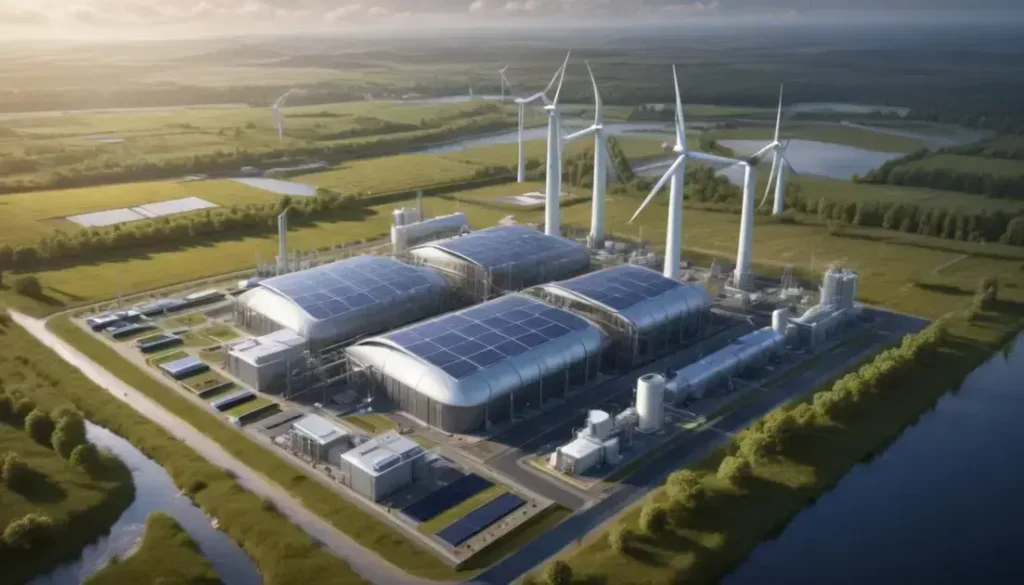The future of electric vehicles (EVs) in Canada is promising, driven by government incentives, advancements in battery technology, and an expanding charging infrastructure that collectively enhance accessibility and consumer acceptance of EVs.
The landscape of electric vehicles is evolving rapidly. With General Motors making significant strides, how are Canadian businesses evolving alongside?
GM Sales Surge: A Closer Look
General Motors (GM) has experienced a remarkable surge in sales during recent quarters, largely driven by the growing demand for electric vehicles (EVs). As the automotive landscape shifts towards greener alternatives, GM has strategically positioned itself to meet this demand. The company’s commitment to sustainability is evident in its innovative technology and expanded EV lineup.
Factors Behind the Sales Surge: The rise in GM’s EV sales can be attributed to a combination of technological advancements, aggressive marketing, and a nationwide push towards cleaner transportation. Recent models featuring enhanced battery range and charging capabilities have made these vehicles more appealing to consumers.
In addition to appealing products, GM’s partnership with state and federal governments to boost infrastructure investment plays a critical role. This collaborative effort ensures adequate charging stations are accessible, which is essential for the convenience of potential buyers. The successful marketing campaigns also emphasize the benefits of driving electric, which resonates well with environmentally conscious consumers.
Furthermore, GM is leveraging its established reputation in the automotive market to gain trust among potential customers. By highlighting the long-term savings associated with electric vehicles, such as lower maintenance costs and fuel expenses, GM is effectively converting interest into sales.
Cassandra Garber: Leading the Charge
Cassandra Garber has emerged as a pivotal figure in the electric vehicle (EV) transition, steering General Motors towards greater sustainability practices. Known for her innovative thinking and strategic insights, she plays a crucial role in shaping the company’s EV strategy.
Driving Innovation: Garber’s leadership has led to significant advancements in battery technology and vehicle design, making GM a frontrunner in the EV market. Under her guidance, the company emphasizes research and development, aiming to produce efficient, reliable electric models that meet consumer needs.
Her commitment to sustainability extends beyond product development; Garber advocates for responsible sourcing of materials. This focus on sustainability not only aligns with global trends but also strengthens GM’s brand among environmentally conscious consumers.
Moreover, Garber is instrumental in fostering partnerships with governments and other organizations to enhance EV infrastructure. By advocating for expanded charging networks, she helps mitigate concerns regarding range anxiety, thus encouraging more consumers to consider electric vehicles.
Through targeted marketing campaigns, she effectively communicates the benefits of switching to electric. Garber’s vision for a cleaner future positions GM as a leader, not just in the automotive industry, but in the fight against climate change.
Factors Closing the Gap with Tesla
General Motors is rapidly closing the gap with Tesla in the electric vehicle (EV) market, primarily through innovative strategies and forward-thinking technologies. A key factor in this competitive race is GM’s commitment to research and development. By investing heavily in battery technology and vehicle performance, GM aims to create EVs that not only rival Tesla’s capabilities but also cater to consumer preferences.
Enhanced Features and Affordability: GM has also focused on enhancing vehicle features, such as improved range and faster charging times, which are crucial for consumer acceptance. Their new models aim to provide comparable performance, making them attractive alternatives to Tesla vehicles.
The introduction of affordable models plays a significant role in attracting a broader customer base. By offering competitively priced EVs, GM addresses the cost concerns that often deter potential buyers, thus expanding market reach.
Additionally, GM is establishing strategic partnerships to bolster its EV infrastructure. Collaborations with charging network providers enhance the convenience of owning an electric vehicle, making it easier for consumers to transition from traditional gas vehicles. With these efforts, GM is positioning itself as a viable contender in a market largely dominated by Tesla.
Advancements in Battery Technology
Advancements in battery technology are at the forefront of the electric vehicle (EV) revolution, significantly influencing the automotive industry. As manufacturers like General Motors invest in research, the aim is to enhance the performance and efficiency of EV batteries. This focus on innovation leads to longer range capabilities and shorter charging times, which are essential for wider consumer adoption.
One significant leap is the development of solid-state batteries, which offer greater energy density compared to traditional lithium-ion batteries. These batteries promise to be lighter and safer while providing longer lifespans. As a result, they address critical consumer concerns regarding performance and reliability, paving the way for more robust EV offerings.
Another key advancement is the utilization of recycling technologies that repurpose old batteries. This not only reduces costs but also minimizes environmental impact, aligning with growing sustainability goals. Companies are increasingly focused on creating closed-loop systems, where materials are reused and recycled, thus enhancing the sustainability of battery production.
As battery technology continues to evolve, it remains crucial for automakers to stay ahead of emerging trends. By prioritizing these advancements, leaders in the automotive sector can ensure their vehicles remain competitive in an ever-growing market.
The Role of Affordability in EV Adoption
The role of affordability in electric vehicle (EV) adoption is increasingly significant as consumers weigh their options in the automotive market. Despite the environmental benefits of EVs, high purchase prices can deter potential buyers. Therefore, making EVs more affordable is essential for achieving widespread adoption.
Manufacturers like General Motors are actively working to reduce production costs while maintaining quality. By leveraging advancements in battery technology and manufacturing processes, they aim to offer more competitively priced models. This strategy not only enhances market appeal but also positions EVs as viable options for a broader audience.
In addition to reducing sticker prices, various incentive programs are being implemented to assist consumers financially. These include government rebates, tax credits, and financing options that make electric vehicles more accessible. Such initiatives can significantly reduce the effective cost of ownership, prompting more consumers to consider switching to EVs.
Moreover, the total cost of ownership is a critical factor influencing consumer decisions. EVs typically incur lower operating costs due to reduced fuel and maintenance expenses. By communicating these benefits clearly, manufacturers can help potential buyers recognize the long-term savings associated with EV ownership, further driving adoption.
Canadian Market Insights into EV Demand
The Canadian market for electric vehicles (EVs) is witnessing significant growth, driven by changing consumer preferences and increased environmental awareness. Recent studies indicate that more Canadians are considering EVs as viable alternatives to traditional gasoline-powered vehicles, leading to a substantial rise in demand.
Government incentives play a crucial role in this trend. Various provincial and federal programs offer rebates and tax credits, encouraging consumers to make the switch. These financial incentives not only reduce the initial purchase price but also highlight the government’s commitment to reducing greenhouse gas emissions.
Moreover, as charging infrastructure expands across the country, range anxiety—a common concern for potential EV buyers—is gradually diminishing. With convenient charging stations becoming more prevalent in urban and rural areas alike, Canadians are increasingly confident in the practicality of owning an electric vehicle.
Market research shows that younger consumers, especially millennials, are leading the charge towards EV adoption. This demographic is more inclined to prioritize sustainability and is actively seeking eco-friendly transportation options. Recognizing this shift, automakers are tailoring their marketing strategies to appeal to this environmentally conscious audience.
The Future of Electric Vehicles in Canada
The future of electric vehicles (EVs) in Canada looks promising, driven by innovative technology and supportive policies. With a growing emphasis on sustainability, both consumers and manufacturers are shifting their focus towards cleaner transportation options. This transition is evident in the increasing variety of electric models available, catering to different consumer needs.
Government initiatives play a pivotal role in shaping the future of EVs. The Canadian government has set ambitious targets for reducing greenhouse gas emissions, aiming for net-zero emissions by 2050. These policies encourage investments in EV infrastructure, including more charging stations across urban and rural areas, making it easier for Canadians to adopt electric cars.
Furthermore, advancements in battery technology are expected to drastically improve the performance and affordability of electric vehicles. As manufacturers develop batteries with longer ranges and quicker charging capabilities, the practicality of owning an EV will appeal to a wider audience.
Additionally, increased collaboration between automotive companies and energy providers is fostering innovations in renewable energy sources. This partnership aims to create sustainable energy solutions that power EVs, supporting Canada’s commitment to a greener future. With the right investments and strategies, Canada is poised to lead in the global EV market.
In Summary: The Bright Future of Electric Vehicles in Canada
As we look to the future, electric vehicles (EVs) are set to play a crucial role in Canada’s transition to sustainable transportation. With advancements in technology and an increase in available models, consumers have more options than ever.
The support from the Canadian government through policies and incentives is also key. These efforts make EV ownership more accessible and attractive, encouraging more people to make the switch to electric.
Moreover, improvements in battery technology will likely lead to longer ranges and faster charging times, addressing common concerns that deter potential buyers. The collaboration between automakers and energy providers will enhance sustainability further.
In conclusion, Canada is well on its way to becoming a leader in the electric vehicle market. By embracing these changes, Canadians can contribute to a greener planet while enjoying the benefits of modern, efficient vehicles.
Frequently Asked Questions
What are the main benefits of electric vehicles (EVs)?
Electric vehicles provide significant benefits, including lower operating costs, reduced greenhouse gas emissions, and less dependence on fossil fuels.
How does the Canadian government support EV adoption?
The Canadian government offers various incentives, such as rebates and tax credits, to encourage consumers to purchase electric vehicles.
What advancements are being made in battery technology?
Recent advancements in battery technology focus on creating batteries with longer ranges, faster charging times, and improved sustainability through recycling efforts.
Is charging infrastructure sufficient for current EV needs in Canada?
Yes, charging infrastructure is expanding rapidly across Canada, addressing consumer concerns about range anxiety and making EV ownership more practical.
How do electric vehicles compare to traditional vehicles in terms of maintenance costs?
Electric vehicles typically have lower maintenance costs compared to traditional vehicles because they have fewer moving parts and do not require oil changes.
What is the future outlook for electric vehicles in Canada?
The future of electric vehicles in Canada is bright, with continued technological advancements, government support, and growing consumer acceptance paving the way for widespread adoption.


